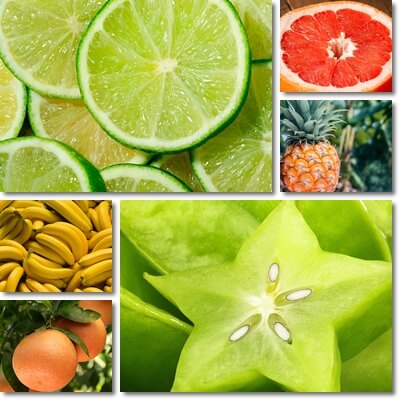When it comes to fruits, opinions are divided between fruits being healthy, but bordering on unhealthy because they naturally have plenty of sugar which should be enough to make people consider reducing their intake, and fruits being perfectly healthy, despite their sometimes high sugar content, and good to eat in whatever amounts one desires, and not just that, but also perfectly capable of sustaining the body all by themselves such as in the case of fruitarian diets.
Whatever your views on fruit intake, it might help to know that most fruits are low glycemic index foods, that is, they have a limited glycemic impact and do not raise blood sugar levels too much too fast, when consumed in normal food amounts, suited to one’s individual nutritional requirements.
Even fruits that are moderate glycemic and high glycemic, such as bananas, mango, papaya, pineapple or watermelon, are low glycemic load, that is, they do not cause that much of a rise in circulating blood sugar when consumed by portion/serving.

What is the glycemic index?
The glycemic index, GI, is a numerical scale that measures how much and how fast the carbohydrates in a food raise circulating blood sugar levels after eating. The glycemic index score can be calculated for any food, but fruit, vegetables, grains, nuts, seeds, milk and some dairy, some seafood, processed foods and meals made with sources of carbohydrates are typically considered.
Foods such as pure fat (e.g. oil, lard), meat, eggs, fish and some seafood do not technically have a glycemic index score because they do not have any carbs to raise blood sugar levels – they are called zero-glycemic foods.
Find out more about the glycemic index.
Glycemic index (GI) score:
- Low glycemic index foods: 0-55
- Moderate glycemic index foods: 56-69/70
- High glycemic index foods: 70-100
What is the glycemic load?
The glycemic load, GL, is a numerical scale similar to the glycemic index. But compared to the glycemic index which measures how much and how fast of a rise in circulating blood sugar levels a food causes in general, the glycemic load measures how much and how fast of a rise in circulating blood sugar levels a serving of a food causes.
So the glycemic load focuses on the carbohydrate content of a serving of a food which makes for more practical numbers, some feel. But the glycemic index remains still extremely relevant because the glycemic load score of a food is calculated based on the glycemic index.
Glycemic load (GL) score:
- Low glycemic load foods: 0-10
- Moderate glycemic load foods: 11-19
- High glycemic load foods: 20+

Fruits glycemic index list
- GI stands for glycemic index (it’s not always a fixed number, even for the same type of fruit)
- GL stands for glycemic load (per 100 g serving, unless otherwise specified)
Low glycemic fruits list
- Apples glycemic index: GI 39, GL 5-6
- Apricots: GI 30, 30+, GL 3
- Asian pears: GI 18-26, GL 2-3
- Avocado: GI 15, GL 1.2
- Bananas (underripe, slightly green or not fully ripe): GI 50-55, GL 11-12
Note: some bananas have been found to have a GI score of only 42 - Blackberries: GI 25, GL 2-3
- Blueberries: GI 40-53, GL 5-8
- Carambola (star fruit): GI 36, GL 2.4
- Cherimoya: GI 32, GL 6
- Cloudberry: GI 44, GL <4
- Cranberries: GI 45, GL 5.5
- Currants, redcurrants: GI 25, GL <3.5
- Currants, white currants: GI 25, GL <3.5
- Currants, black currants: GI 25, GL 3.8
- Custard apple: GI 30, GL 7.5
- Durian: GI 49, GL 13
- Feijoa (pineapple guava, guavasteen): GI 31, GL 4
- Figs: GI 35-40, GL 7-8
- Gooseberries: GI 15, GL 1.5
- Grapefruit: GI 25, GL 3
- Grapes: GI 45-53/55, GL 8-9
- Guava: GI 31-33, GL 4-5
- Jujube: GI 20, GL 4
- Kiwano (horned melon): GI 48, GL 3.6
- Kiwifruit, green: GI 50-55, GL 7-8
- Kiwifruit, golden variety: GI 50-55, GL 8-9
- Lemon: GI 22-32, GL 2-3
- Lime: GI 24-32, GL 2.5-3
- Litchi, lychee: GI 48-55 (rare cases), GL 8-9
- Mandarin (mandarin orange): GI 42, GL 5.6
- Mango: GI 55 (borderline on moderate), GL 8
- Mulberries: GI 25, GL <3
- Nectarines glycemic index: GI 40, GL 4
- Oranges: GI 40, GL 5
- Passion fruit: GI 30, GL 7
- Pears: GI 38, GL 6
- Peaches: GI 42, GL 4
- Persimmon (kaki): GI 50, GL 9+
- Physalis (Peruvian groundcherry, cape gooseberry): GI 35, GL 4
- Plantain (cooking banana): GI 38, 38+, GL 12
- Plums: GI 40, GL 5
- Pomegranate: GI 53, GL 8-10
- Pomelo: GI 22, GL 2
- Prickly pear: GI 7, GL 1
- Quince: GI 35, GL 5+
- Raspberries: GI 25 to 40, GL 3 to 5
- Strawberries glycemic index: GI 40, GL 3
- Sweet cherries: GI 20-25, GL 3-4
- Tangerine: GI 42, GL 5.6
- Tomatoes: GI 15, GL 1-2
Other low glycemic fruits: citron, hawthorn berries, kumquat, longan, mangosteen, rambutan, rose hip berries, rowan berries, sapodilla, sapote, sea-buckthorn berries.
Moderate glycemic fruits list
- Bananas (ripe): GI 62, GL 14
- Breadfruit: GI 65-68, GL 18
- Cantaloupe: GI 65, GL 5
- Dates (average values): GI 60, GL 45
- Jackfruit glycemic index value, ripe: GI 63-65, GL 15
Note: raw, unripe jackfruit can have a GI as low as 11, and a GL of only 3 - Kiwifruit glycemic index value: GI 58, GL 8.5
- Golden kiwifruit: GI 58, GL 9
- Grapes glycemic index (some varieties): GI 55+, GL 9
- Litchi, lychee: GI 60 (average score), GL 9.9, rounded at 10
- Mango glycemic index: 56-60 (average score), GL 8-9
- Papaya glycemic index: GI 59, GL6 6+
- Pineapple index value: GI 66, GL 9
- Tamarind: GI 65, GL 40
High glycemic fruits list
- Bananas (ripe and overripe): 70+, GL 16
- Cantaloupe (very ripe, very sweet varieties): GI 70, 70+, GL 6
- Watermelon: GI 72-80, GL 5.4-6
Considerations
Not all fruit are a fixed number of the glycemic index score. Depending on variety and growing conditions which impact fruit nutrition, the glycemic index score of most fruits will vary at least slightly. Also, ripe and overripe fruits will have a higher GI value, while unripe and underripe fruits tend to have slightly lower GI values – this is because the ripening process coincides with a natural rise in sugar content in fruits which translates into more pregnant effects on blood sugar levels.
The glycemic index fruit list above considers fresh, raw fruits. Dried, cooked, preserved or otherwise processed fruits may have significantly different glycemic index values. Lastly, the impact of a food on a person’s blood sugar can vary according to the person’s current state of health, whether or not they are diabetic, how they choose to eat the fruit (if they eat it alone or pair it with other foods and which foods) and individual blood sugar responses.
